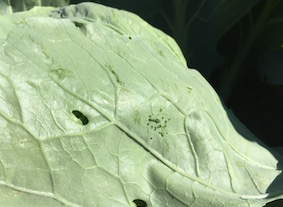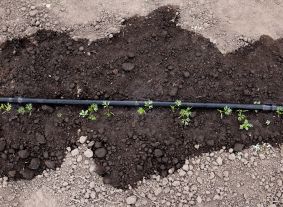Keeping Away Destructive Cabbageworms and Loopers
Views: 5775

My father fell ill and passed away recently. He was a life-long farmer in a long lineage of farmers dating back to the 1600s. It’s all he thought about and all he knew. From harvesting to planting to cabbageworms. As his body got old and couldn’t handle the labor of the job, he’d ride along in the pickup truck with my brother. Alternatively, he’d watch the farm carry on without him from the house. He’d pepper my brother with questions about the daily activities and advise when appropriate. And for him it was always appropriate.
During his last few weeks my father’s mind found a reality of its own. Instead of being in the hospital, my father was still on the farm. Although he was a potato farmer, Dad was fixated on planting the spring cabbage. He’d try to get out of the clunky hospital bed to transplant the cabbage seedlings he believed were growing under it. Every day, he’d ask the nurses to come by with the tractor so he could pull the transplanting crew down the field. He’d ask if Ludy, a field hand from long ago, was finished with the planting for the day. Summer was coming fast and it all had to get into the ground. Dad was a farmer up until the end, concerned for his crop.
Honoring him with Cabbage
After my father’s funeral I pulled a dozen or so green cabbage plants from my brother’s seedling bed. I brought them back to Boston and planted them in honor of my father. I have many other veggies in the garden, but I care most about this cabbage. So when I spotted cabbageworm moths and their larvae I got into protective mode.
Cabbageworm moths are those pretty small white moths with a black dot on the wings that flit from plant to plant beginning around May. While pretty, they and their larvae, the cabbage worm, are destructive, eating large holes in leaves of any brassica-type plant (cabbage, broccoli, collards, etc.). The larval stage is light green with a small yellow stripe along its body. These look very much like cabbage looper larvae: same color and same destructive behavior but with white stripes. Cabbage worms prefer younger leaves and can be found on the top of leaves while loopers prefer the underside of the leaf.
Control Measures
Check for larvae beginning in early spring by examining leaves, top and bottom. Manual removal (and squishing) is the first step. A biological, non-toxic insecticide called Bt (Bacillius thuringiensis), can also be applied to the crop to attach the larvae and eggs (but won’t harm beneficials, apparently). I’ve never tried Bt, however give it a try.
I’ve read that cabbage moths stay away from strong scents and that planting items like lavender or marigolds near cabbage will deter them. Along those same lines, an insecticidal soap with a strong scent added to it, such as garlic or clove, could possibly work to keep cabbage moths away.
Meanwhile I will continue checking leaves and squishing larvae, hoping for a cabbage crop my dad would be proud of.
Meet Ellen Wells
When you’re raised on a farm, you can’t help but know a thing or two about gardening. Ellen Wells is our expert on edible gardening.…
Ellen's Recent Posts

Asparagus






